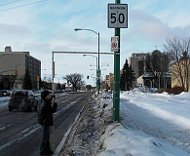2/17/2011
Canada: Speed Limit Signs Inadequate Near Camera TrapWinnipeg, Canada caught ignoring standards for speed limit sign placement near photo radar units.

Activists in Winnipeg, Canada yesterday charged city leaders with using photo radar to exploit a hard-to-see sign used to provide notice of a change in the speed limit. To make its case, WiseUpWinnipeg broke out a copy of the official regulations governing signs, the Manual of Uniform Traffic Control Device (MUTCD) for Canada, to determine whether the speed limit signs were placed in accordance with national standards. The group concluded that several of the signs are substantially out of compliance.
"For signage to be effective it has to be properly and consistently placed as per MUTCD requirement so as to optimize visibility for motorists, otherwise what is the point?" asked WiseUpWinnipeg spokesman Todd Dube. "Unless of course the point is revenue and not safety."
Dube and his fellow activists created a measuring tool set to the maximum allowable height and distance specifications. They found one of the top ticket-producing speed camera locations, the intersection of Grant Avenue and Wilton Street, has the photo radar unit placed just beyond a single sign announcing a reduction in the maximum legal speed from 60 km/h (37 MPH) to 50 km/h (31 MPH). This sign is placed at least two feet above the maximum permissible height, which the group pointed out significantly reduces visibility at night because it is above the reach of most headlights.
For comparison, the group examined roads maintained by the Province of Manitoba and found provincial authorities strictly adhered to MUTCD requirements in all respects.
"City signage does not meet MUTCD standards by design as a means of entrapping motorists who are unaware of the reduced limit," WiseUpWinnipeg's Larry Stefanuik said in a statement. "The Grant at Wilton scenario is a clear example of the predatory intent behind the program."
Stefanuik and Dube are calling on Winnipeg to refund tickets issued at the intersection because the city itself failed to comply with the law.


